The Musicarta Canon Project Module Nine
Accompaniment with RH Triads
Now you have started playing your own full left hand accompaniment, your next step is playing along with broken-chord triads in the right hand. But the same accompaniment pattern doesn’t work for all treble parts. It’s easy to fix the problem by changing the order of your accompaniment pattern notes, and this will make you a lot more confident about creating your own root-fifth-octave-tenth accompaniments.
Here is the module audio performance.
Download the module teaching notes here.
Right hand triads with accompaniment
Revise the right hand triad (three-note chord) string from Module Three. Play the chords with a one-note bass line.

Now build the root, fifth, octave, tenth (R, 5, 8, 10) ladder on each bass note in turn.
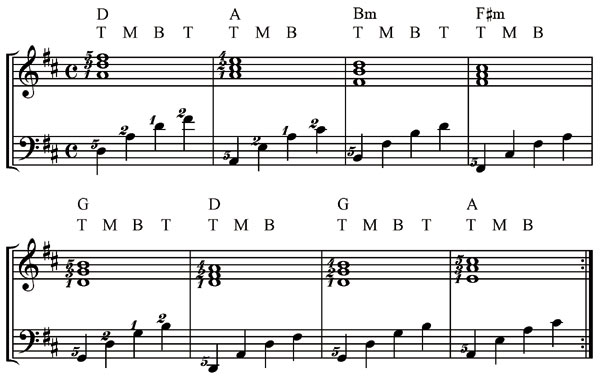
Finish the chord sequence using the chord chart:
Broken-chord triads in the right hand
Recall the right hand broken chord pattern from Module Five. Here’s the example we will be using:
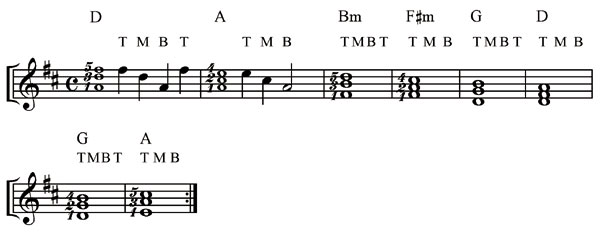
Note that:
- This is a two-bar repeating bottom, middle, top (BMT) pattern:
- The semibreve (whole note) chords in the first two bars of the music example are there just to show you what chord to prepare – you don’t play them.
Rehearse the pattern with a single-note bass line.
Now play the broken-chord triads over the R, 5, 8, 10 left hand accompaniment. The audio performance file is right after the next piece of written-out music, which shows the right hand triads as whole notes with the broken chord pattern in BMT coding. As a free-playing keyboard musician, you want to move to a position where you almost-automatically break up right hand triads into interesting, repeating patterns.

‘Bald spots’
This is a nice version and a good achievement, but the combination of left hand and right hand chord tones creates ‘bald spots’. Listen again to the audio performance, and compare it with the improved version immediately below.
Here is the 'corrected' version. Can you see how it has been 'fixed'?
‘Bald spots’ occur where there are too many roots and fifths coming together, and the listener has to wait too long to hear the third/tenth (the third is the ‘sweet’ note in a triad). Playing the third (tenth) in both hands at the same time also makes a bald spot.
The bald spots are corrected in the second version by changing the order of the notes in the left hand. Listen the two versions (repeated here) one after the other until you can hear the improvement.
The new LH accompaniment pattern
In the improved (second) version of the accompaniment, the left hand plays R, 5, 10, 8 instead of the standard R, 5, 8, 10 pattern – the last two chord tones are switched around. (Read again, and check that you understand.) Here is the written-out music for the new left hand accompaniment pattern.
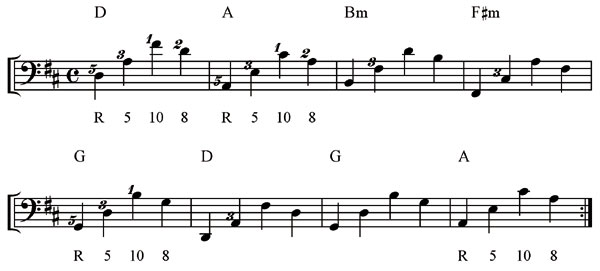
Practise this new R, 5, 10, 8 accompaniment pattern.
Notice that the fingering has changed. Don’t try to hold onto the root or the fifth – use the sustain pedal to hold the notes and let your hand move freely to get to the tenth. Expect to practice a good deal.
Add the RH triads (whole chords) back in.
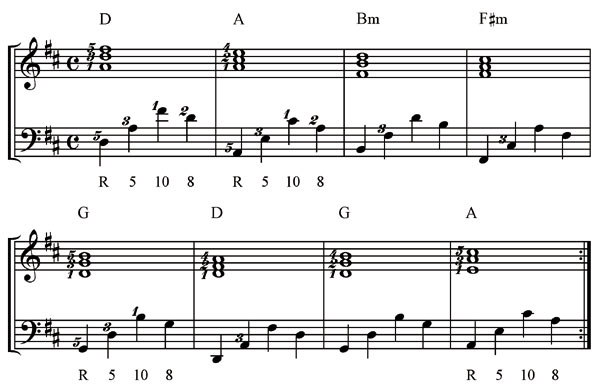
As soon as you add the right hand triads back in, you will see if your left hand R, 5, 10, 8 pattern needs more practice! When you can play the new LH accompaniment pattern and the straight triads together comfortably, play the RH broken chord pattern over the new accompaniment.
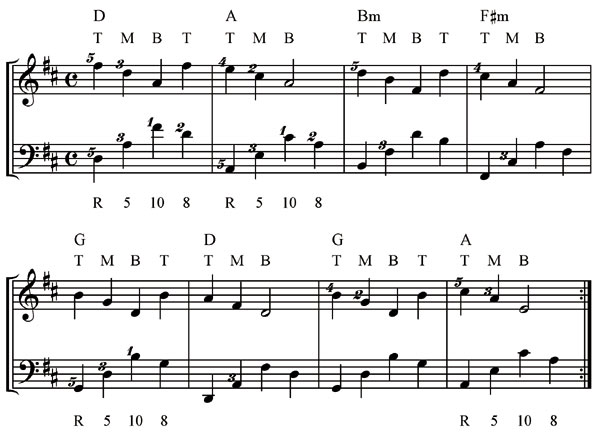
Compare the sound you have now with the old ‘bald spot’ version. You will hear that it’s been worth the trouble.
Accompaniment patterns often have to be ‘tweaked’ like this in the light of what the right hand is playing. We explore this further in the next Canon Project module. Most left hand accompaniment patterns are made of the root, fifth, octave and tenth of the presiding chord, so time spent playing around with them like this is never wasted.
Using musical shorthand
Look at the last music example again. There’s a great deal of information in it. Here it is, labelled.
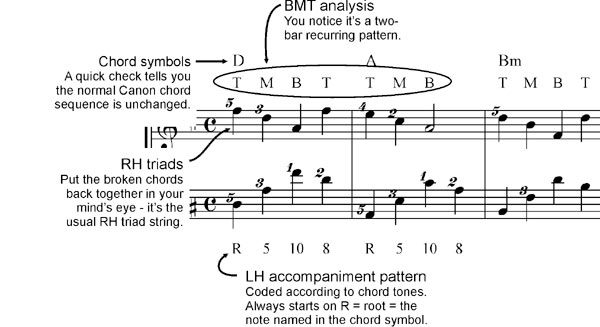
Written music tends to work against development of musical creativity because ‘the dots’ monopolise your brain. Unless you work hard at it, you don’t have the attention left to spot the patterns. If you see through the dots to the patterns, you get to ‘own’ the music, and learn to play in a much more creative way.
Pachelbel’s Canon is made up of patterns which express a simple but very pleasing chord sequence, and this makes it an excellent piece to focus on patterns and develop your creativity. Here is the information in the music above with ‘the dots’ removed altogether.

Study the table until it makes sense to you. The ‘usual triad string’ is this familiar music.

The first chord is a D major triad with F sharp as the top note, the second chord is an A major with E as the top note, and so on. We can express this in shorthand as well:

Feed that into the table.

This is a picture of how creative musicians ‘think’. Try to play the final Module Nine version from this table alone.
Writing music out in full is time-consuming and laborious, but without some written record, it’s easy to forget what you have done. Consider sketching your own compositions this way, using all the kinds of shorthand demonstrated.
Transposing challenge (optional)
One advantage of examining a chord sequence as thoroughly as the Musicarta Canon Project does, is that the in-depth knowledge about chords and chord sequences you acquire ‘spins off’ into all your playing.
‘Transposing’ – easily playing music you know in a different key – is a great way to practise this advanced benefit.
If you work through the Canon Project Transposing mini-series on the home musicarta.com site, you will learn the Roman numeral system of naming chords, and then you will be able to see even deeper into the chord structure and read the module performance like this:

The chords of the Canon chord sequence are now expressed as Roman numerals – they are ‘the chords in any key’. There is a full briefing on the Roman numeral system of naming chords in the first module of the Canon Project Transposing mini-series on the Musicarta site. If you are committed to learning how harmony works, this system is highly recommended.
Here is a transposing table for D major to C major.

In the Roman numeral system, the Canon chord sequence is this:
Read those Roman numerals off in the key of D in the table above, and you will see the familiar D, A, Bm, F#m, G, D, G, A chord sequence emerging.
Your transposing challenge is to transpose the Canon Module Nine performance into C major. Follow a logical step-by-step build-up:
- Using the two tables above, find out what the Canon chords are in the key of C major. Write them out in ordinary chord symbols if you need to and rehearse.
- Find the familiar-shaped bass line (roots – the notes of the chord symbol letters). Play it with the ‘usual string’ of right hand triads (in C) from above.
- Find and rehearse the original R, 5, 8, 10 accompaniment pattern in C. Find the right hand chords (the ‘usual RH triad string’) and break them up in the two-bar T M B T │T M B pattern.
- Put the hands together.
- Change the left hand accompaniment chord tones to R, 5, 10, 8 for the ‘improved version’.
This what your finished version should sound like.
The audio file demonstrates some of the preliminary steps too.
Expect to take a number of sessions to accomplish this. Each of the bullet points above is a ‘tick-box task’ on its own. As a minimum, play the basic Canon chord sequence triads in C major with a single-note bass line.
Thanks for visiting MUSICARTA! Come again soon!
|
|
Get an overview of Musicarta in manageable monthly slices – and keep up to date with new postings. Read all about it on the Musicarta Newsletter page. The Musicarta News - regular encouragement to learn and progress! Or – get the Musicarta RSS feed. [What’s that?] |
|
OUT NOW! |
THE MUSICARTA BEAT & RHYTHM WORKBOOK At last! An effective approach to keyboard rhythm & syncopation skills. Learn more! |
ONLY $24.95! |
THE MUSICARTA
|
The MusicartaA methodical approach to keyboard syncopation for
|
PUBLICATIONS
exciting keyboard
creativity courses
CHORDS 101
WORKBOOK

~HANON~
video course

Musicarta
Patreon
PENTATONICS
WORKBOOK
video course

Creative Keyboard
video course

BEAT AND RHYTHM
WORKBOOK

- Volume 1 -

12-BAR PIANO
STYLES WORKBOOK

MUSICARTA MODES
WORKBOOK

PIANO STYLE

CANON PROJECT
video course

VARIATIONS
video course


- Piano Solo -
video course

- Piano Solo -


YouTube playlists








 THE LOGO
THE LOGO
